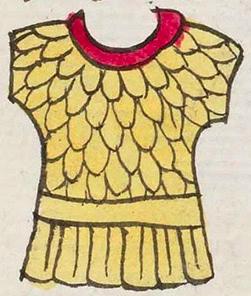Cozohuipilecan (Mdz38r)
This glyph could be considered either a compound or a simplex. The cozohuipilli was a tunic (huipilli) decorated with yellow parrot (cozotl) feathers, and here it stands alone for the place name, Cozohuipilecan. There is a possessor suffix (-e-) embedded in this name that is not unequivocally represented visually. The locative suffix -can is definitely not shown visually.
Stephanie Wood
The huipilli is commonly considered a woman's garment, but here it would appear to be a warrior's costume, and therefore probably worn by a man. This tunic is somewhat different from the other example of a cozohuipilli in this collection (see below, right). The Codex Mendoza includes many warriors' garments as tribute items (beginning about folio 36 recto and forward), and several are made of yellow feathers with a red trim at the neck.
Stephanie Wood
coçohuipilecā. puo
Cozohuipilecan, pueblo
Stephanie Wood
c. 1541, or by 1553 at the latest
Stephanie Wood
garments, tunics, prendas, trajes de guerreros, feathers, plumas, nombres de lugares

cozo(tl), a yellow parrot, https://nahuatl.wired-humanities.org/content/cozotl
huipil(li), a blouse or tunic, https://nahuatl.wired-humanities.org/content/huipilli
-can (locative suffix), https://nahuatl.wired-humanities.org/content/can-2
Codex Mendoza, folio 38 recto, https://digital.bodleian.ox.ac.uk/objects/2fea788e-2aa2-4f08-b6d9-648c00..., image 86 of 188.
The Bodleian Libraries, University of Oxford, hold the original manuscript, the MS. Arch. Selden. A. 1. This image is published here under the UK Creative Commons, “Attribution-NonCommercial-ShareAlike 3.0 License” (CC-BY-NC-SA 3.0).

